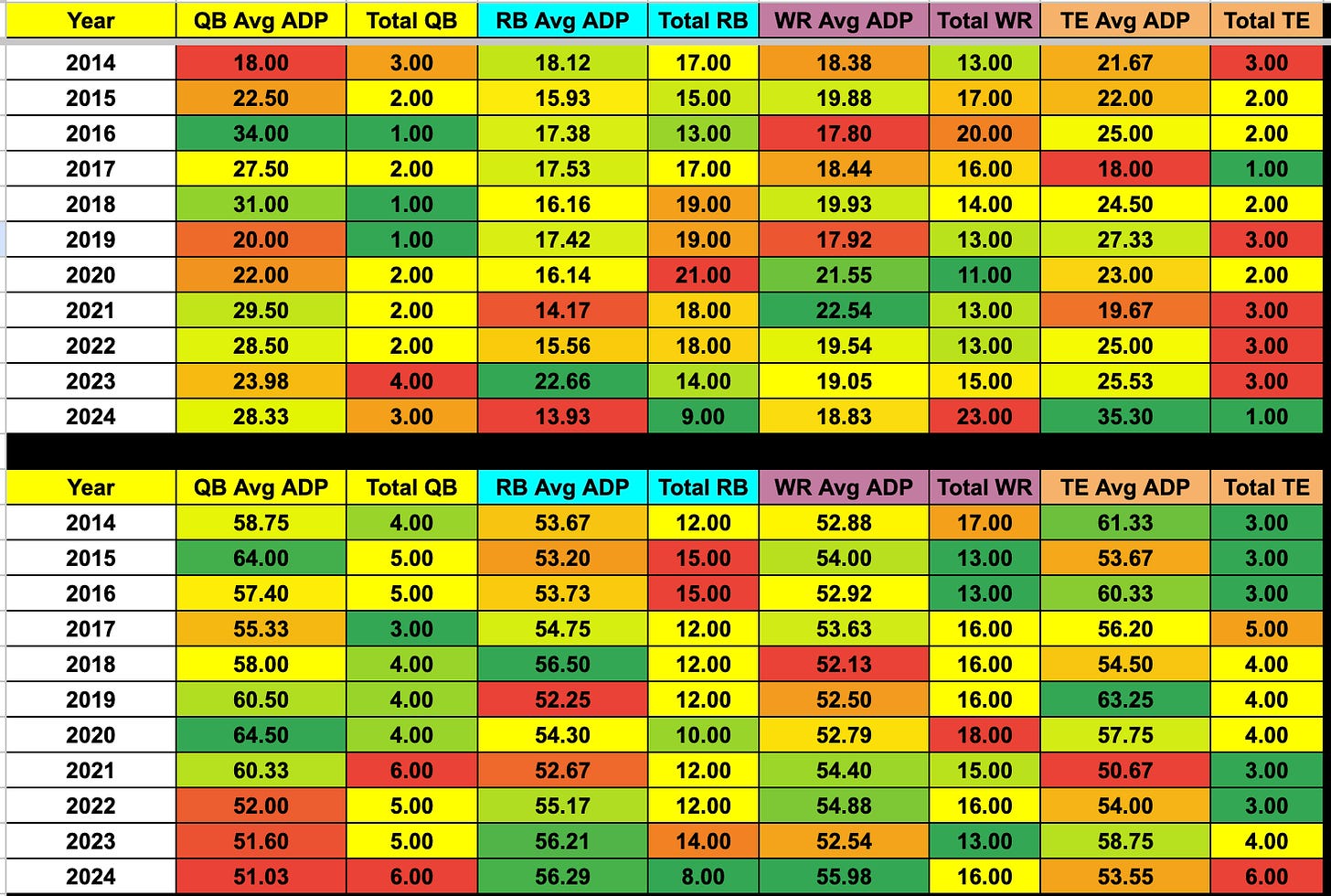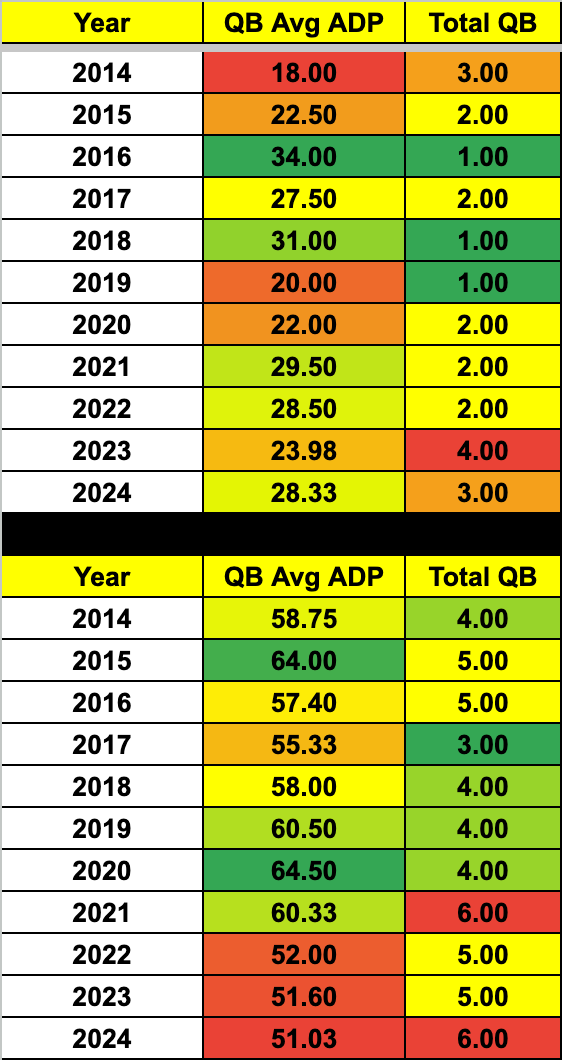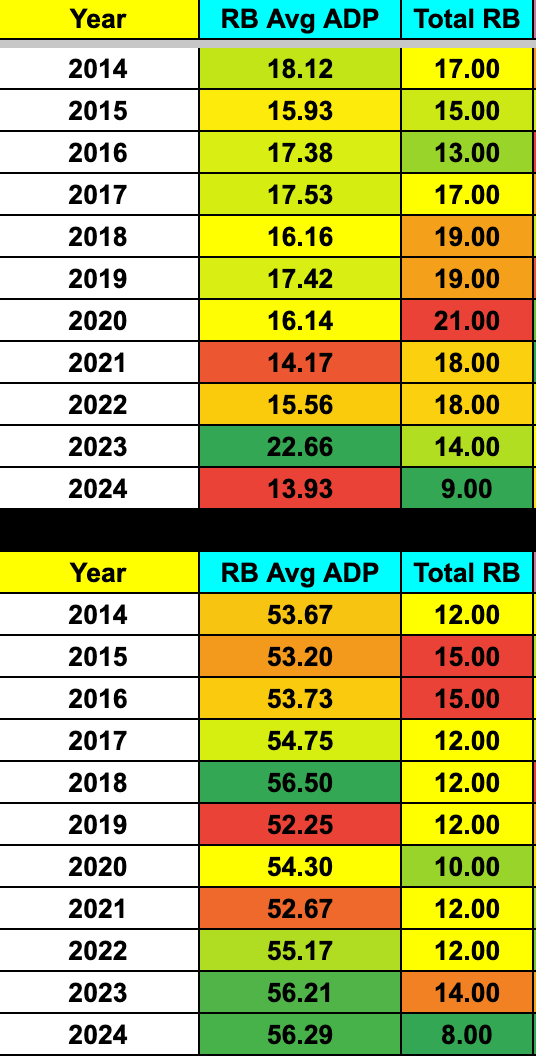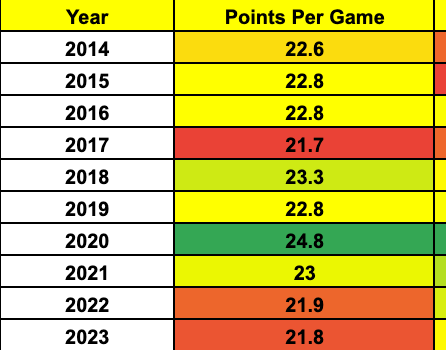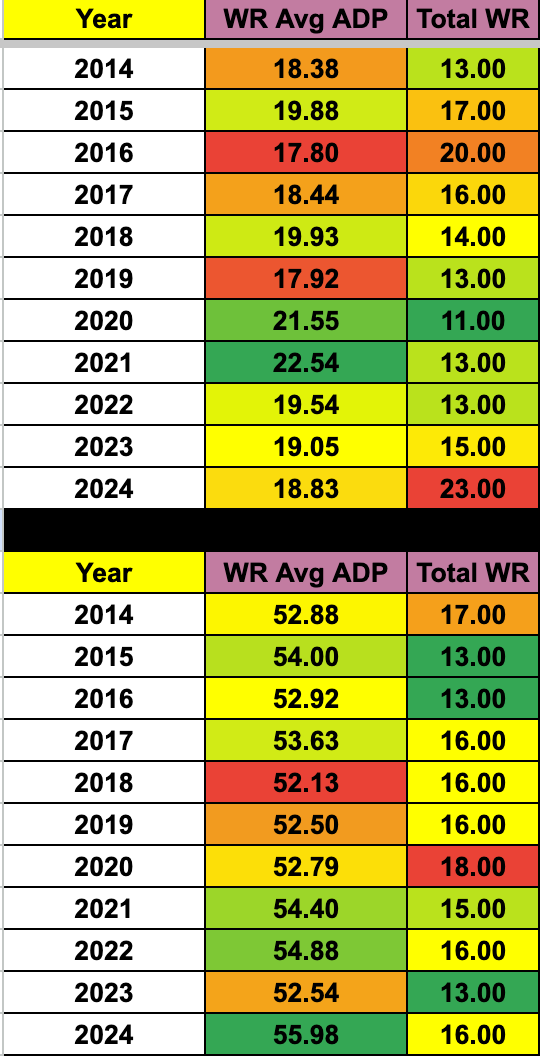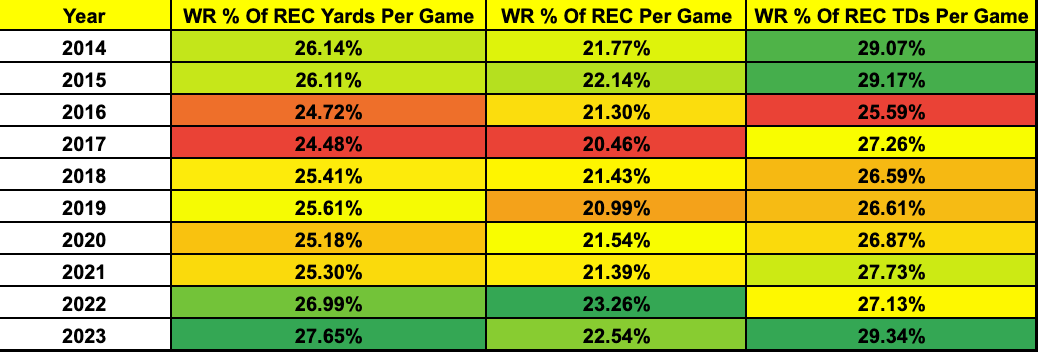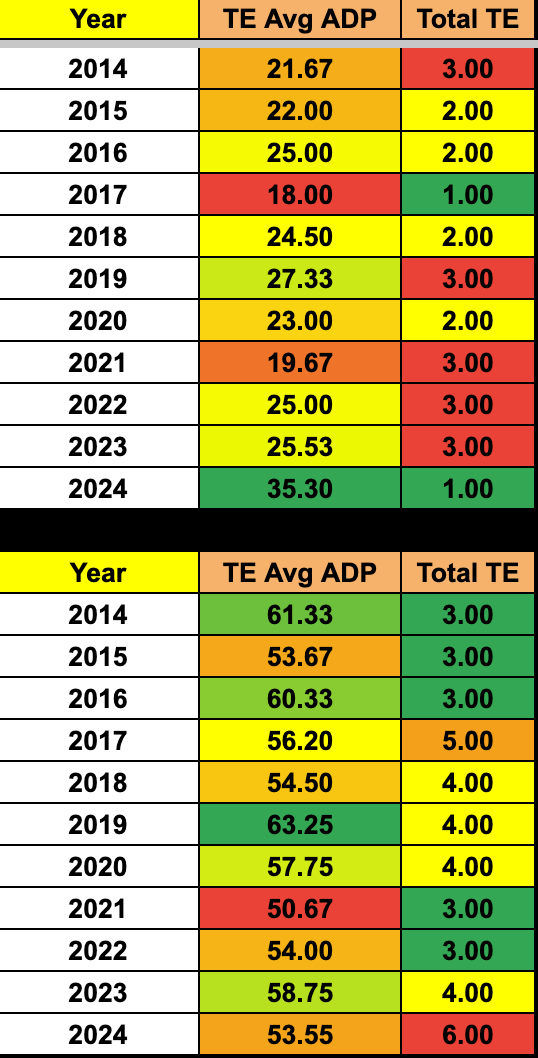Positional Draft Trends - Analyzing 10+ Years of ADP Data
If you consume any fantasy content at all, and since you are reading this it’s a pretty fair assumption you do, you’ve heard someone talk about how WRs are more expensive than ever this year in fantasy football drafts.
I am here to tell you for one, that this is true, WRs are going earlier than ever in drafts, and what to do with that information is now the question you should be asking yourself. We will talk about potential ways to act on this new trend later, but first, let’s look at the other positions you’ll have on your rosters and see if new trends are occurring at them as well.
To analyze these trends, we will be looking at the ADP data by position from fantasy drafts starting in 2014 up to 2024.
ADP Data Taken From Underdog, Fantasy Football Calculator, and FantasyPros
The Data
Here is a breakdown so you can be familiar with what exactly we are looking at on these charts. What we are looking at here is simple, so I’ll keep this short and to the point as we don’t need to spend a ton of time trying to understand what these numbers mean.
Top Chart:
ADP Data by Position for Players Taken in Rounds 1-3 in Fantasy Drafts
QB Avg ADP: Where a QB that went pick 1-36 in fantasy drafts went on average.
Total QB: The total number of QBs that were picked in Rounds 1-3 of fantasy drafts.
RB Avg ADP: Where an RB that went pick 1-36 in fantasy drafts went on average.
Total RB: The total number of RBs that were picked in Rounds 1-3 of fantasy drafts.
WR Avg ADP: Where a WR that went pick 1-36 in fantasy drafts went on average.
Total WR: The total number of WRs that were picked in Rounds 1-3 of fantasy drafts.
TE Avg ADP: Where a TE that went pick 1-36 in fantasy drafts went on average.
Total TE: The total number of TEs that were picked in Rounds 1-3 of fantasy drafts.
Bottom Chart:
Everything I said above but instead it’s for players taken in Rounds 4-6 and picks 37-72 in fantasy drafts.
Trends by Position
Now that what we are looking at here is laid out, it’s time for us to dive into the trends — position by position.
QBs:
With QBs, there are two noticeable trends here for me, since 2021 QBs have not only started going earlier in drafts — but they’ve been drafted at a higher frequency as well. The position has gone from one that the fantasy community was adamant that you could wait on until the end of drafts — to one that demands you take a top option early.
The answer as to why drafters have done a complete 180 on their stance about how to value QBs looks to be a simple one - Rushing Ability.
Positional Stats are taken from FFToday using the Top 50 Fantasy Point Finishes by position as well as Pro Football Reference.
Before 2020 QBs never made up more than 20% of the rushing TDs scored in a season and ever since — they have broken that 20% mark in three of the past four seasons. In those same four seasons, QBs have put up a 10-year high in Rushing Yards per Game, Rushing TDs per Game, and Percent of Total Rushing Yards.
With QBs now running the ball more and better than ever, the trend of QBs moving up draft boards begins to look like a logical decision by the market.
I do not think that means you need to be caving and paying up at QB every draft, you just need to make sure if you are waiting on QB — that whoever you get further down the board also brings rushing upside to the table.
For RBs, we will have a lot more to talk about and analyze how to act, but for QBs, the answer to why this trend is occurring and why it’s correct is simple, the league is starting to run the ball more with their QBs which gives the position more access to potential fantasy points than it had in years past.
RBs:
Total RBs Being Taken in Rounds 1-6 in Fantasy Drafts from 2014-2024
2014: 29
2015: 30 (+1)
2016: 28 (-2)
2017: 29 (+1)
2018: 31 (+2)
2019: 31 (+0)
2020: 31 (+0)
2021: 30 (-1)
2022: 30 (+0)
2023: 28 (-2)
2024: 17 (-11)
If RBs were a company the United States would have to give them a government bailout with how badly their stock has performed.
In the last two years, RBs taken in Rounds 4-6 have never been cheaper and this year only 8 RBs are being selected in that range compared to 14 in 2023. Not only is this true, but if you look closer, you’ll see that in 2023 the RB 14-28 went in Rounds 4-6 at an ADP of 56.21, compared to this year where the RB 10-17 are going in those same rounds at an ADP of 56.29, so what you had to pay to get at least a Top 28 RB in 2023 is now what you have to pay to get at least a Top 17 RB. Over the last 10 years, you’ve never been able to get a Top 20 RB this cheap, or anywhere close to this cheap — these low prices for RBs are something we’ve never even come close to seeing before.
While you can make the argument that the ADP for RBs taken in Rounds 1-3 is the highest it has been in 10 years this season, it’s only because the top backs in Christian McCaffrey, Breece Hall, and Bijan Robinson are all going in the Top 8 and they make up a third of the backs being taken in Top 36 picks. So we know that the market still sees the value in the top RBs, but for anything past the studs, the market looks like it can’t be bothered to hit the DRAFT button on those players.
This is the first year the market has bought into the narrative that taking RBs early in drafts is -EV, and while I do believe a correction was needed, let’s take a look under the hood and see exactly how justified this correction is.
On the negative side, two things that stand out are the last two seasons produced the fewest RB Receiving Yards per Game over the last 10 years and that 2022 is tied for the lowest RB Total Share of Receiving Yards per Game during that same time span. The numbers in 2023 recovered slightly from the 2022 lows but there is still no other way to look at it than the last two years for RBs were the worst two-year stretch the position has seen dating back to 2014.
RBs Rushing TDs per Game also look to be taking a hit, which is partly due to the evolution of the Rushing QB stealing more rushing TD equity with each passing season.
Partner that with the fact that 2022 and 2023 produced the lowest scoring seasons of the past 10 years besides 2017, you start to see why the market has the issues with RBs that it does, outside of the injury risk associated with the position of course.
Now with all of this being said, these stats are all just the average of every RB, so top-tier talent at the position is still valuable and you can argue it’s even more valuable than ever since the position has been producing less and less. When you’re playing Fantasy Football, you still need RBs on your team, so while the reason the market is valuing them less looks to make sense — it doesn’t mean the position is any less important than it was before, it just means it’s cheaper than before.
The risk of investing high draft capital in RB is real, but so is the upside — nailing down the RBs that can pay off is the hard part, but if you get that right throughout your drafts the payoff will be great. This might just sound like a whole bunch of nothing so — the point I am trying to get across here is that an RB can still be good while being valued less, so don’t write off trying to build an RB room that can be the best in the league as a way to get ahead of your opponents — especially when drafters are now trying to win their leagues by having the best WR room all while the position is more expensive than it has ever been.
To be clear, this doesn’t mean don’t value WRs, trust me you need to, it just means that you shouldn’t be writing off RBs while they’re cheaper than they’ve ever been. Buy Low Sell High is a saying for a reason.
WRs:
39 WRs are going in the first 72 picks in Fantasy Drafts in 2024, meaning that WRs make up 54.16% of the first 72 picks in drafts. That’s almost 10% more than any other season in our data set.
That is not to say it is unwarranted though, as over the past two seasons the position has posted a 10-year high at Percent of Total Receiving Yards per Game, Percent of Total Receptions per Game, and Percent of Total Receiving TDs per Game — the Top 50 Fantasy WRs have never owned more of the passing game real estate than the past two seasons. So even though we talked about scoring being down, it’s also down for every position.
Where we can ding WRs is here, outside of 2017, the passing game has seen a 10-year low in the last two seasons in Passing TDs per Game, Passing Yards Per Game, Passing Attempts per Game, and Receptions per Game. You can argue this does affect every position since they all rely on the passing game for fantasy output, and while that is true, WRs and TEs don’t have rushing attempts and rushing yards that they can fall back on and still produce like RBs do.
Especially when the rushing game has been trending up over the past four seasons.
So why exactly are WRs more expensive than ever when the passing attack has never been worse? It would seem to be because the market is willing to acknowledge everything going wrong for the RB position but not willing to do the same for WRs. Or could it be that even though volume is down in the passing game — the fact that WRs own more of it than ever before makes up for the shortcomings in the volume department?
I don’t know, and no one does, but what I do know is that you would think for a position to be more valuable than ever in fantasy that said position would be doing better than it ever has, which is just not the case.
My takeaway here is simple, just like RBs, you still need WRs on your fantasy team, and with RBs being cheaper than ever, you can afford to maybe overpay for WRs early in drafts because you aren’t getting punished for it in the form of low equity at RB like you would in years past. This doesn’t change the fact that you’re paying more to draft worse WRs than in years past though. So try to be mindful of that and be willing to take RBs a little earlier than your opponents instead of trying to get a great WR3-5 before your RB1.
TEs:
Remember when we just talked about passing volume being down across the league? Well, unlike WRs, it looks like the market took it seriously, at least when looking at TEs going in Rounds 1-3 — as outside of this year, 2017 was the only year that saw 1 TE get drafted as a Top 36 pick, and the TE in 2017 also went in the mid-second round, whereas this year we were/are dangerously close to not even seeing a TE go in the Top 36.
However, more TEs are going in Rounds 4-6 this year than any other year since 2014, so it’s not like the market has completely written the position off either.
This may sound boring, but my short takeaway here is just that TE usage in the league is evolving and more guys have a path to being the overall TE1 than in years past, so now it just makes more sense for TE6 to go earlier in drafts compared to years past because the TE6’s potential production is greater than it used to be.
When considering that fact, you shouldn’t be reaching to get a Top 3 guy necessarily, but this position is no longer a draft Travis Kelce or wait situation, not leaving the draft with a Top 8 TE puts you at real risk to lose points on the field because more teams should have a TE that can produce meaningful fantasy output compared to years past — and because of that it is now more dangerous than ever to not invest in a TE who isn’t reliant on TDs to put up fantasy points.
Summary:
QBs: Valued as they should be.
RBs: Potentially undervalued.
WRs: Potentially overvalued.
TEs: Potentially undervalued.
This piece took a little longer than I thought so I do apologize about the delay in putting it out, but I do hope you found it both valuable and insightful!
As always, any subs to the newsletter are greatly appreciated!


